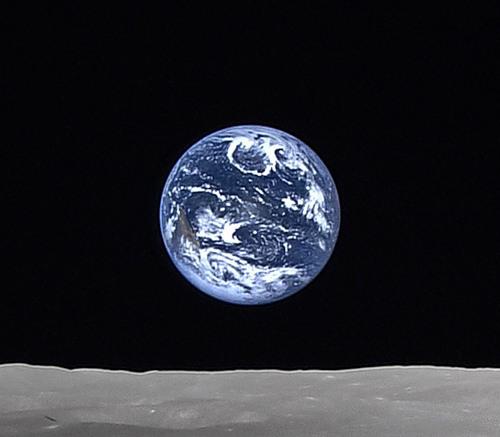Earthrise on the moon ... a common thing
 Bashny.Net
Bashny.Net

Almost all of us know that the Moon always faces the Earth the same of his party. From school physics course, we also know that the reason for this - Earth tides, forever hidden from us back, "dark" side of the moon. The principle of tidal capture postulates that the planet - the owner is almost always on the same point of the firmament of his companion. However, I've said it too clearly, because in fact this is only possible under ideal conditions. The world is fortunately far from ideal, which is allowing us to observe the moon full of sunrises and sunsets of the Earth ...
Astronomers have long noticed that the Moon is a sort of "rocking" during the lunar month, putting us up to 10% of the "dark" side. The result is that even before the flight "Luna 3" cards astronomers had 60% of the lunar surface.
This phenomenon has been called libration. At the moment are 4 types of libration, we also focus on the two main - libration in latitude and longitude.
1.Libratsii latitude caused by tilting the axis of the daily rotation of the Moon to the plane of its orbit (the amplitude of 6 ° 50 min), resulting in the Moon "substitutes" us then north, then south pole.
2.Libratsii longitude are not caused by zero eccentricity of the lunar orbit.
The eccentricity of the orbit in a simplified form displays the degree of deviation of the orbit of the satellite or planet from a perfect circle. 0 means perfect circular orbit. Greater than 0 and less than 1, to the extent thereof, or elongated orbit (elliptical), with e = 1 parabolic, while e & gt; 1 - hyperbolic. As you can see, the orbit is gradually stretched with increasing eccentricity from 0 to 1, torn by e = 1 (the second space on the achievement of the orbit).
Libration of the Moon, seen from Earth.

The eccentricity of the Moon on the average is 0, 05, which is sufficient for the appearance of small deviations between the speed of rotation of the Moon around the Earth, the Moon and the proper rotation on its axis. This provokes the libration in longitude with an amplitude of 7 ° and 54 min.
It is obvious that both types of libration cause movement of the Earth and the Moon in the sky - where the blue planet within a month a huge describes an ellipse with the largest diameter at 18 °. Given that the angular size of the Earth from the Moon is "only" about 2 ° (four times larger than the size of the Moon as seen from Earth), it will allow future lunar colonists to watch, though slow, but spectacular sunrises and sunsets home planet in certain areas of the moon.
Sunrise Earth "libration zones" of the lunar poles, mid-latitude and the equator (the program Stellarium).
But the least patient colonists may well watch it "in the Fast" from the orbit of the moon (probe Kaguya / JAXA).
And a little bonus. Although Iapetus, Saturn, most likely no stargate which managed to please the hero of the book by Arthur C. Clarke "Space Odyssey 2001", yet thanks to the irregularities of the orbit of the satellite, it is possible to observe quite epic sunrises "Lord of the Rings».
Source: habrahabr.ru/post/226543/
Tags
See also
Unusual items were in space
What color is Mars?
Nibiru, Planet Heh, unknown nonsense from Space
Is there life after death: the Facts and evidence
Water
15 interesting facts about water
When I start to do business together with a person, always look - what his wife.
What affects the resistance headphones
Image Sensor Cleaning DSLR

















